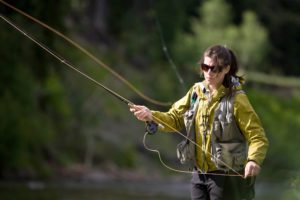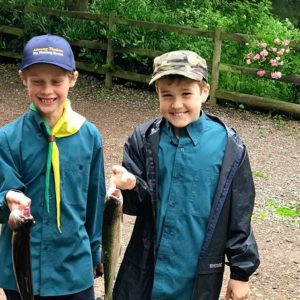
With fishing allowed again, an escape to an idyllic day in the country was much anticipated. We Fly Fish client Mike drove down from London for a guided day on the Hampshire Avon, one of the classic settings for fly fishing.
Here’s how Hardy Fishing, one of the oldest fly fishing tackle manufacturers, describes our top chalk rivers. ‘The Test, Itchen and Hampshire Avon are the world’s most famous fly fishing rivers. Their crystal clear waters flow through the bands of subsurface chalk that run across southern England producing the internationally rare and unique phenomena – the chalkstream. As the rainwater soaks down slowly through the porous chalk geology under gravity, it is filtered and stored in these aquifers. The water eventually emerges from the aquifers as a spring at the source, feeding the river system with very high quality water of a consistent temperature in both summer and winter. The alkaline water that flows in these chalk stream ecosystems is extremely fertile giving rise to an abundance of weed, invertebrates and of course salmon, trout and grayling.’
The River Avon is a designated Site of Special Scientific Interest of national and international importance for wildlife. Natural England, which manages the SSSI scheme and protects our most valuable habitats states ‘The Avon is richer and more varied than in most chalk streams with over 180 species of aquatic plant having been recorded, one of the most diverse fish faunas in Britain and a wide range of aquatic invertebrates. The system has an extremely diverse fish fauna with more species recorded in the Avon than in any other British river. The renowned salmonid fisheries, with wild populations of migratory sea trout Salmo trutta, brown trout and Atlantic salmon Salmo salar.’
River Avon SSSI
After the safety briefing and explanation of the COVID precautions the tackle for the day was rigged up, a Sage X 9 foot 5 weight, Snowbee XS line and Sage Click reel. Waders on for a short walk downstream to a hatch pool. No Mayfly hatching yet, so we waded out to fish the tail of the pool. An olive quill nymph was speculatively cast out which resulted in a few takes and the first brown trout of the day to the net which was safely released. One of the benefits of wading is that the release is so easy with the fish never leaving the water. If the barbless hook doesn’t drop out in the net it is quickly removed with forceps.
After lunch the Mayfly hatch started to gradually build up and trout and grayling were rising to them. Switching to CDC emerger and detached body Danica patterns soon started to attract the interest of the trout. We’d waded up to a tree lined section that protected us from a fairly stiff breeze and Mike had to make some tricky off shoulder roll casts to get the fly in position. As is usually the case, accurate casting was vital to get the fly into the right current seams in the feeding lane. Around 6 PM the Mayfly Spinner fall peaked. This event is when female Mayfly return to the river laying their eggs on the water surface, then fly a little further to touch down on the surface again. Assuming the trout don’t get them first of course! At this point the trout were very tuned into the Mayfly and we had big splashy rises all around us. Time flew until it was time to go, with a limit bag of brown trout taken or released. A wonderful Mayfly day on the Hampshire Avon.




